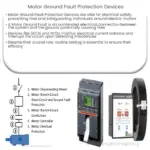Explore how a Residual Current Device (RCD) works to prevent electrical shocks and fires, understand its importance, and learn about its types.
Understanding the Functionality of a Residual Current Device (RCD)
Commonly found in homes and offices, a Residual Current Device (RCD) is a key player in ensuring electrical safety. This remarkable device minimizes the risk of electrical shocks, a hazard that could potentially cause fatal injuries.
Working Mechanism of an RCD
The fundamental principle of an RCD operation is based on monitoring the balance of electrical current flowing through it. It closely watches the electricity entering and leaving a circuit, ensuring they match. If it detects an imbalance, it swiftly disconnects the power.
- Monitoring Phase: The RCD constantly monitors the incoming and outgoing current in the live and neutral wires of a circuit.
- Detection Phase: An imbalance indicates a fault or leak in the circuit. This could occur if a person accidentally touches a live part of the circuit, causing some of the current to pass through them instead of returning via the neutral wire.
- Interruption Phase: If such an imbalance is detected, the RCD instantly reacts, disconnecting the electricity supply to the circuit, typically in just a few milliseconds.
Why Are RCDs Important?
RCDs are of utmost importance due to their role in protecting against electrical shocks and preventing fire hazards caused by faulty wiring. They react much quicker than traditional fuses or circuit breakers, thus providing superior protection against electric shock.
Types of RCDs
- Fixed RCDs: These RCDs are installed in the consumer unit and offer the highest level of protection as they protect all the wiring and the sockets on a circuit, and also any connected appliances.
- Socket-Outlet RCDs: These are special socket-outlets with an RCD built in. They can be used in place of a standard socket-outlet and provide protection to appliances plugged into them.
- Portable RCDs: These plug-in devices offer an additional level of protection to any appliance or device that is plugged into them.
In conclusion, a Residual Current Device, with its diligent surveillance and prompt action, plays a crucial role in maintaining the safety of electrical systems and preventing accidents, thus ensuring our well-being and security.




